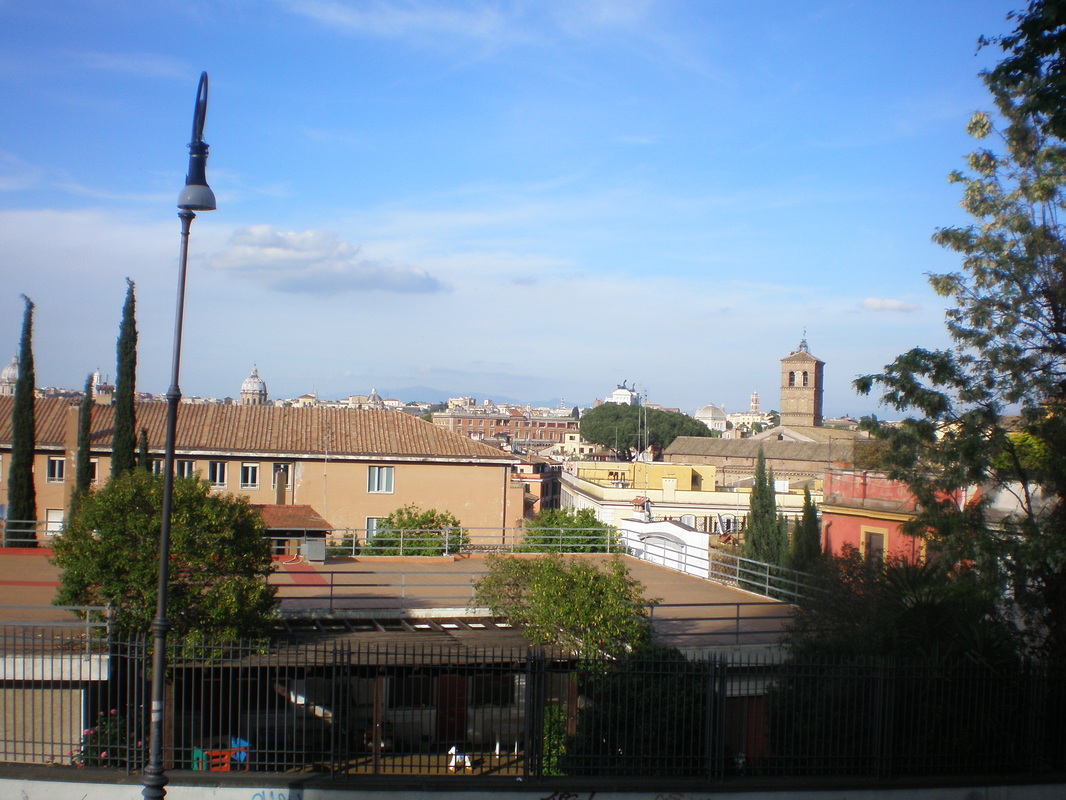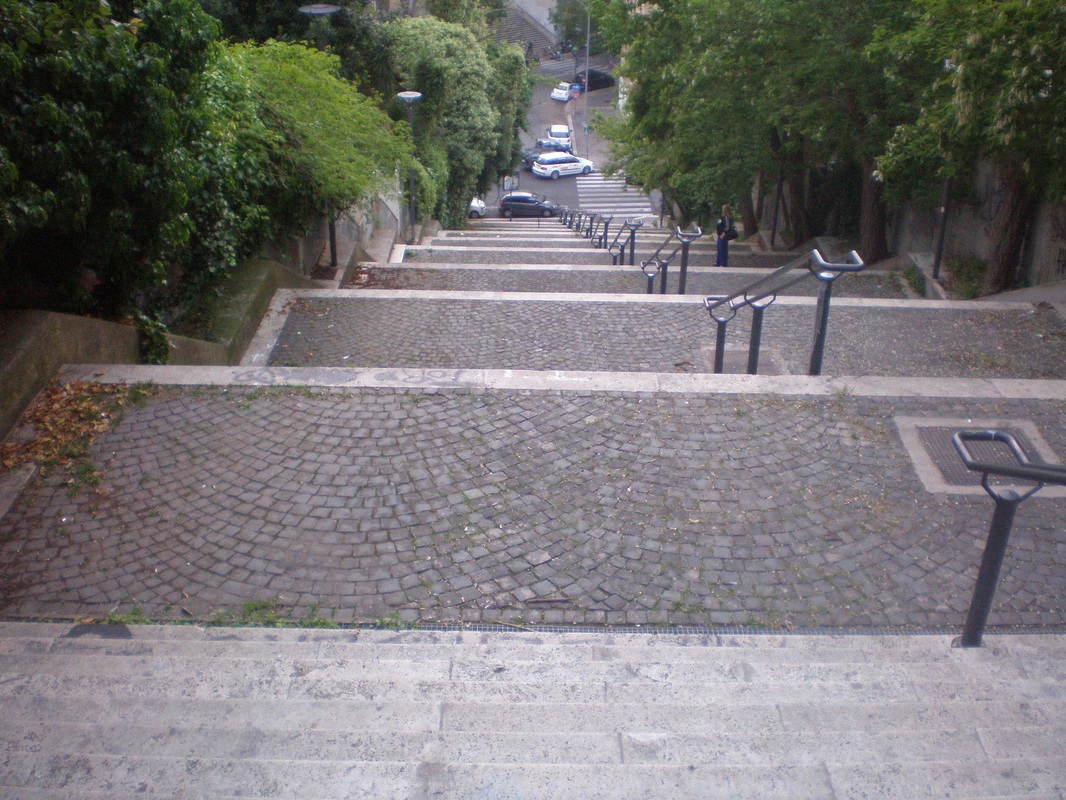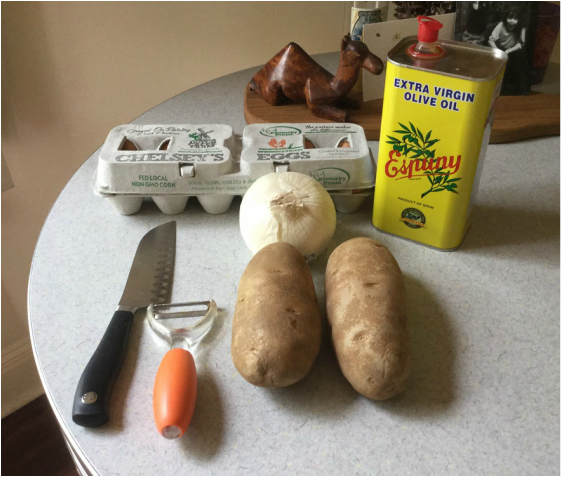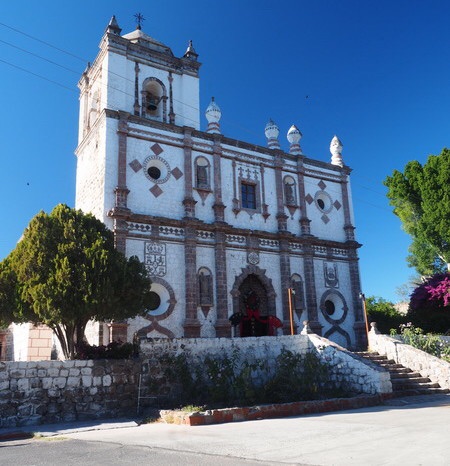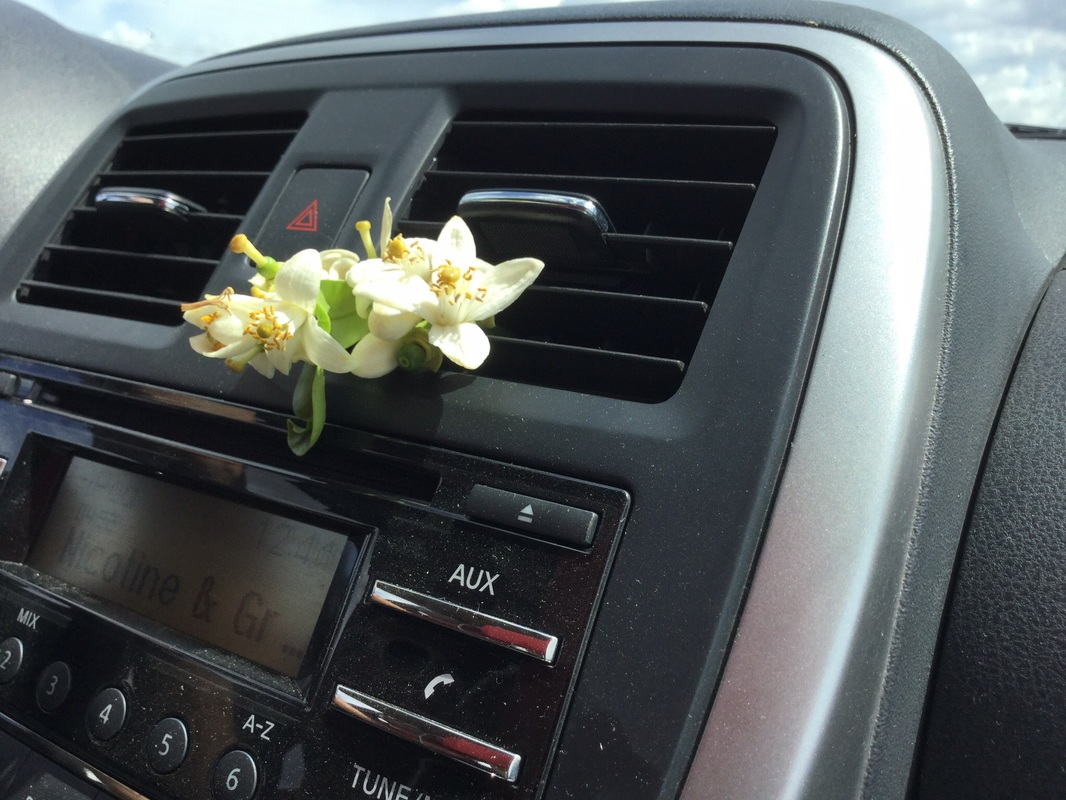Our first stop of the night was at the charming Vini e Oli (wine and oil!). This is a convivial and low key affair. Here we drank nice pours out of plastic cups on the sidewalk for about 1€. Panini and snacks are available, too.
|
Man oh man, I love me a night out in Pigneto. As if I don't get enough 'outside the city time' in Monteverde! Pigneto holds a special place in my heart, partly due to (wisely) celebrating my 30th birthday here, chugging vino rosso and stuffing myself full of the most divine porchetta to ever have been roasted. Also not to be forgotten, an incredible show by the incredible brothers Pontiak at the excellent venue, Circolo degli Artisti. This industrial working class neighborhood certainly shares similarities to Monteverde. Pier Paolo Pasollini filmed here, too, calling the outskirts, "la corona di spine che cinge la città di Dio" (the crown of thorns which surrounds the city of God). Indeed, Pigneto stands in stark contrast from the grandeur of Rome central. Still, Pigneto has endured much and the strength of it's inhabitants and strong cultural history are to be admired. Now justly starting to receive the attention it deserves, Pigneto is the kind of place you feel lucky to explore. You'll also be glad you are hungry (and thirsty!). Like Monteverde, Pigneto is outside of the city walls and is easily accessible via public transit. Although it is possible, If not recommended to walk, an option which became known to me on the aforementioned birthday night when there was not a bus in sight! So, take a bus, OK. Or, it seems that very soon the metro will connect out here which will be great for commuting but is bound to change the vibe. One of my favorite things about Pigneto are the vini sfusi joints dotted about town. I have briefly mentioned this and I will be brief here, too. Vini sfusi, or vino sfuso spots are little storefronts which sell 'loose' or 'bulk' wine from stainless steel drums on draft. Dispense your selected wine into your plastic jug and pay for it by the liter, usually between 1.50 and 3€. In some of the smaller neighborhoods and outside the city center of Rome, you will see these spots on nearly every street. Buying an entire liter is the best deal by far and many places simply won't sell you a glass, preferring to sell by the liter. The nice thing about some of Pineto's vini sfusi spots is the possibility to order 'vini in mescita' (by the glass). Plus, most of the sfusi spots serving up individual glasses will also provide a few snacks and a nice glass will run only 1€. We looked into several of these hip spots for research purposes (you're welcome!) and each had there own merits.
Our first stop of the night was at the charming Vini e Oli (wine and oil!). This is a convivial and low key affair. Here we drank nice pours out of plastic cups on the sidewalk for about 1€. Panini and snacks are available, too.
1 Comment
Our big splurge in Monteverde was at the appropriately named L'Osteria di Monteverde. This was a wise choice and you are about to see why. The clear winner for our coveted finest dinner in Rome classification, this unassuming Osteria on a side street in Monteverde offered a nice mix of traditional and contemporary cuisine, a fitting approach in this part of town. We ate here on May Day, which in Rome means favas, and not just any favas, but raw favas in their little husks. Snacking on these tender, small and flavorful beans alongside salty bites of Pecorino Romano is a nice way to be welcomed. The menu here will tempt you in many ways. They have a lovely wine list with fair prices. We went with a half liter of the house white (pecorino) followed by a half liter of house red (nebbiolo). At 6€ each, this was plenty of wine for two lushes.
Visiting a city like Rome can and should be one of life's great pleasures. That being said, visiting Rome might also be one of life's more overwhelming achievements! One way I have found to minimize exhaustion and maximize the Roman experience is to stay slightly outside the city center. This may not be for everyone, but I would have it no other way. Getting outside of the historic center is such a great way to see daily life and find little pockets that just might offer the things which elude so many when visiting such a popular area. You wouldn't go to New York and only visit Times Square! Monteverde is that place for me and has offered a much needed city respite on all of my visits. If you are familiar with the Pier Paolo Pasolini classic, Mamma Roma, you have likely caught a glimpse of Monteverde. Although Pasolini grew up in Bologna, Monteverde became, for some time, his adopted home. Certainly, he was rightly critical of the very things about this area which I enjoy: it's tall apartment buildings and urban grit nestled closely to the beautiful images which Rome typically conjures. For me, there is great beauty here, too, and I love being the only tourist around. People here are friendly, welcoming and helpful and from here, the centro storico is 15 minutes away by public transit. Or, do what I do and walk it. Clocking in at just around an hour, I love starting my day this way. Walking to the top of Monteverde past all the butchers and cafes, wine shops and pizzerias, and then winding down to the river through the posh Trastevere isn't an inconvenience, for me it is a bonus. It's a good thing you are walking, too, since Monteverde offers a ridiculous number of very fine eateries, fancy and casual. Eating out here as opposed to fighting for a table in the city will make you feel like you finally know what you are doing (for once!) and the chances of a disappointing meal decrease dramatically.
Having a chance to visit Italia is quite a joy indeed. The food! The art! The history! The people! Does such immense beauty exist elsewhere? Of course it does, but you'd never know it while here. And Roma. Ah, Roma, when I leave, my heart (feet) will ache for thee! Roma always seems to be a logical starting point for me. A classic beauty, this is a do not miss city on my list. And still, with it's chaotic energy and millions of things to do, eat and see, it can seem a bit overwhelming to be sure. Luckily, it is totally chic to drink wine most the day long, so have a glass (or bottle!) and relax. You couldn't possible see and do all this magical city has to offer and I find the sooner I come to this realization the better. This is not to say one should come to this city without some semblance of a plan. It will be very comforting knowing before you arrive a few things you'd certainly like to do and to have a general idea of the city's setup. The nice thing is, just walking from place to place can be it's own reward. The architecture, cobbled streets, fountains, hidden alleyways and open air restaurants could keep you gawking all day long.
Tortilla Española (Spanish omelette) is a classic dish served in cafés and bars throughout Spain. Served as a montadillo (on bread) or as a pincho (wedge) you'd be hard pressed to resist this. Any way you have it, this is a filling and tasty snack, morning or night. Also, if you have a wonderful friend who brings you Asturian Sidra, the only logical way to thank him is with a nice big Tortilla Española and a little spread of tapas (thanks Scott!). I make a tortilla de patatas con cebolla, that is, an omelette with potatoes and onion (!). I know some people think onion has no place in a tortilla and to those people I suggest you make your own! I like the sweetness a bit of stewed onion adds here, so I always include it. The simple tortilla ingredients are inexpensive and wholesome. Do use the best eggs and olive oil you can afford, though.
Do you love juicy, funky cider as much as I do? If so, you need to plan a trip to Asturias in Northern Spain. Sidra (hard cider) has been made and consumed here since the 8th century. Asturias produces about 80% of Spanish cider, anywhere from 20-30 million liters annually, so why haven't you heard of it yet? I'd have never known the delight of this part of Spain were it not for Scott, a good friend, world traveler and fellow sidra enthusiast. Scott, who is a constant promoter of the region, has spent much time there and many years living in Spain. One trip-or taste of sidra- and you will easily see the culinary value here. I had a more than memorable trip there a few years past and will visit again this summer. So, more on sidra definitely to come, but for now I offer up this primer. Asturian Sidra (cider) is tart, dry and tastes of ripe apples. This cider has funk and you will either love it or you won't! A born companion to pungent blue cheese or heavily smoked chorizo, Sidra is a complex beverage which reminds me a bit of old Champagne, with crisp mineral notes and that aforementioned funk. I said it was funky, right? Asturias is a narrow and oft overlooked strip of land situated between the better known Galicia to the West and the Basque Country to the East. This area is not only home to fine sidra, but also to beautiful coastline (and pristine seafood) and the dramatic Picos de Europa mountains. The food here is assertive and begging to be washed down with copious amounts of sidra. One of the most famous culinary exports of the region is the delightfully piquant Arenas de Cabrales blue cheese. With it's deep blue veins and a creamy texture, blue cheese lovers will delight in this one. Made with either solely cows milk or the more traditional mix of cow, goat and sheeps milk, to be named Arenas de Cabrales, all the milk must be from Asturias. We have had this cheese in Asturias when it has been so ripe it completely numbs your mouth. All the more reason to drink gallons of sidra! Somewhere between 4 and 6% alcohol, sidra can and will be drunk all night.
It is a little sad to begin the return trip North. The good news is now you know all the great spots to stop for a swim, grab delicious food and buy cold beers. Another piece of good cheer is the inviting town of San Ignacio. The friendly village of San Ignacio offers stunning vistas, a beautiful misión and a real taste of life on the Baja Peninsula. We were a little worn down by this point in the trip, but made sure to take advantage of one of the many hiking trails on offer. Information on the city and trails are expertly provided by Jane Beard Ames at Casa Leree. We followed a path from behind Casa Leree toward a large cross on the hilltop. After so many hours and days of viewing cacti from afar, it was so lovely to be up close and personal. Don't get too personal, though, as even a light brush against certain cacti can be painful.
La Paz, our furthest point south, is a lovely change of pace. Situated around four hours South of Loreto, this bustling city is named 'Peace' for a reason. With it's long and beautiful Malacón (seafront walkway) and plenty of stunning beaches on the outskirts of town, La Paz is bound to be a favorite to many. For us, other than being able to say we drove the entire peninsula, we found no reason to continue the additional 130 mile trek to the resort town of Cabo San Lucas. While there are cheaper options in town, we splurged on the two room penthouse suite at Posada Colibri. At 120$ per night this was by far our most expensive room, but there were three of us and at this point in the trip we were happy to have such spacious and comfortable digs. The rooms have strong wifi, great views and come with an excellent poolside breakfast of coffee, tea, fresh breads, fruit, yogurt and eggs. Our hosts were incredibly friendly, helpful and even supplied us with snorkels and tips for exploring the coastline via kayak. We were drawn to Pichilingue beach with the promise of kayak rentals, access to other private beaches and a small island nearby which was home to a colony of sea lions. Pichilingue beach is a short and pretty drive out of town taking the Malacón south until it turns into the 11 highway, a total of around 12 miles. We stocked a foam cooler with drinks and snacks and headed on out.
Once you have soaked up plenty of sunshine and have accumulated an appropriate amount of sand in your car, load up and head to the charming seaside town of Loreto. Small and easy to navigate, with a beautiful misión and town center, Loreto is a relaxing place to spend a few days. This town has quite the history and is thought to be the oldest human settlement in Baja. We have twice stayed at La Damiana Inn and it is a great and affordable option. Clean and with good wifi, coffee in the mornings, a fabulous garden area and exceedingly friendly hosts. Plus, from here you are so close to the clam extravaganza of your dreams! At Almejas Conchos, clams are literally the name of the game and you will be glad they are. Did I mention the owner here is super friendly? He is.
In Mulegé, I like to stay at the locally owned Hotel Hacienda. The rooms have air conditioning, wifi, there is a pool *sometimes* and they have free coffee in the mornings. Oh, and it is cheap! Around 30$ for a double. Check out the photos in the bar area for a glimpse back in time. What I really love about this place is the enormous grapefruit tree in the courtyard which has the most fragrant blossoms in the spring. It perfumes the whole place. Remember when you leave to grab a few blossom sprigs. This way you can fashion an air freshener for your rental car, which at this point probably smells a bit like whale breath, Modelo and spilled coffee. If a seafood breakfast isn't in the cards, seek out Asadero Los Arcos (or at least the sign for it). This charming birria de cabrito (stewed small goat) stand serves up delicious birria.
|
Archives
February 2016
Categories
All
|






